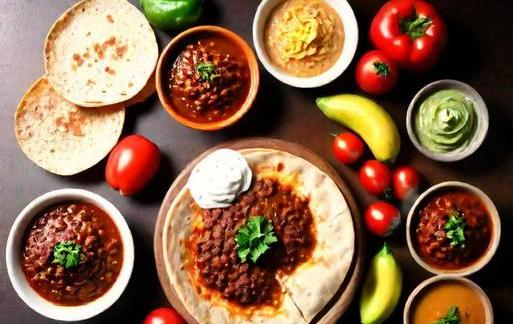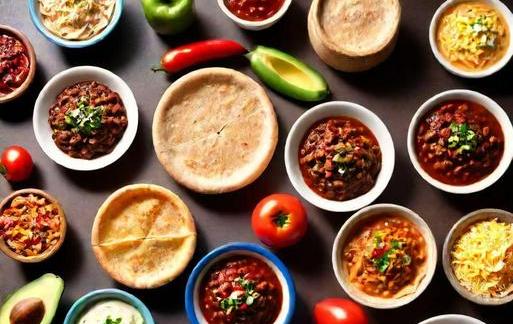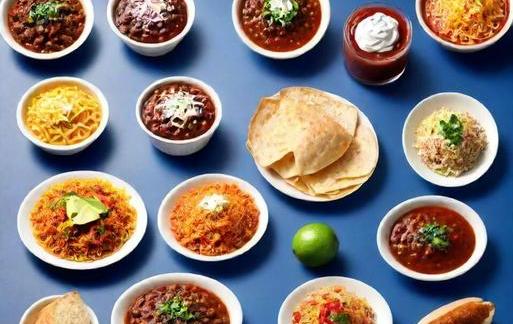- You are here:
- Home »
- Food
- » [REVEALED] Hispanic Foods That Start With E
[REVEALED] Hispanic Foods That Start With E
Note: This page contains affiliate links.
As an Amazon Associate, I earn from qualifying purchases when you click on the link, but you are not charged extra.
Hispanic cuisine is a diverse tapestry of flavors, colors, and traditions that reflect the rich cultural heritage of the Spanish-speaking world. From the spicy and savory to the sweet and indulgent, Hispanic foods encompass a wide range of culinary delights. In this exploration, we delve into the realm of Hispanic foods that start with the letter "E." From traditional staples to regional specialties, each dish tells a story of history, geography, and a deep connection to cultural roots.
Contents
List Of Hispanic Foods That Start With E

1. Empanadas
Empanadas, a beloved snack across Latin America, are pockets of dough stuffed with a variety of savory fillings. These hand-held treats can feature ingredients like seasoned meats, cheeses, vegetables, or a combination of these. The dough is typically made from a mix of flour, water, and sometimes lard, resulting in a flaky and golden crust. Empanadas vary from country to country, showcasing the diverse flavors that characterize Hispanic cuisine.
2. Enchiladas
Enchiladas are a classic Mexican dish that consists of rolled tortillas filled with a variety of ingredients. The filling often includes meats such as chicken, beef, or pork, combined with cheese, beans, and spices. The rolled tortillas are then topped with a savory sauce, typically made with tomatoes, chili peppers, and other flavorful ingredients. Enchiladas are baked until bubbly and served with garnishes like sour cream, guacamole, and fresh cilantro.
3. Elote
Elote, also known as Mexican street corn, is a popular and iconic snack in Mexican cuisine. Grilled or boiled corn on the cob is coated with a mixture of mayonnaise, cotija cheese, chili powder, and lime juice. The result is a flavorful and satisfying treat that perfectly balances sweetness, creaminess, and spice. Elote is often enjoyed during festivals, fairs, and as a street food delicacy.
4. Escabeche
Escabeche is a preservation and flavoring technique used in Hispanic cuisine. This method involves marinating and pickling vegetables, often carrots, onions, and jalapeños, in a seasoned mixture of vinegar, water, and spices. The result is a tangy and crunchy side dish that can accompany various main courses. Escabeche is a versatile condiment, providing a burst of acidity and brightness to the palate.
5. Espinacas A La Catalana
Espinacas a la Catalana is a traditional Spanish dish hailing from Catalonia. This spinach-based dish combines sautéed spinach with pine nuts, raisins, and garlic, creating a harmonious blend of flavors and textures. The pine nuts add a delightful crunch, while the raisins bring a touch of sweetness to the dish. Espinacas a la Catalana is a testament to the skillful balance of contrasting elements in Hispanic cuisine.
6. Ecuadorian Ceviche
Ceviche is a dish that transcends borders, but each region adds its unique twist. Ecuadorian Ceviche typically features seafood, such as shrimp or white fish, cured in citrus juices like lime or bitter orange. The acidity "cooks" the seafood, leaving it with a refreshing and zesty flavor. This dish is often accompanied by plantain chips or served on a bed of lettuce, highlighting the diverse culinary landscape of Ecuador.
7. Ensalada De Frutas
Ensalada de Frutas, or fruit salad, is a refreshing and vibrant dish commonly enjoyed across many Hispanic countries. The combination of tropical fruits, such as mangoes, pineapples, and watermelon, creates a colorful medley that captures the essence of Latin American agriculture. Some variations include a drizzle of honey or a sprinkle of chili powder to enhance the sweetness and add a hint of spice.
8. Estofado
Estofado, a hearty stew, is a comfort food found in various Hispanic cuisines. This slow-cooked dish typically features meat, such as beef or pork, simmered with a medley of vegetables, herbs, and spices. The result is a flavorful and tender stew that warms the soul. Estofado recipes can vary widely, with each region putting its spin on this comforting and filling dish.
9. Empanadas De Leche
Empanadas de Leche, or milk empanadas, are a sweet and indulgent treat enjoyed in some Hispanic cultures. These empanadas are filled with a luscious mixture of sweetened condensed milk, vanilla, and cinnamon. The dough is often flavored with citrus zest or other aromatic ingredients. Once baked, Empanadas de Leche boast a golden, flaky exterior that gives way to a creamy and sweet interior, making them a delightful dessert or snack.
10. Ecuadorian Tamales
Tamales are a staple in many Latin American countries, and Ecuadorian Tamales add their unique touch to this beloved dish. These tamales are made with a masa dough that is filled with a combination of meats, vegetables, and spices. The mixture is then wrapped in banana leaves and steamed to perfection. The result is a tamale with a distinct flavor, infused with the essence of the tropical banana leaves.
Exploring Hispanic foods that start with the letter "E" unveils a culinary world rich in diversity, history, and tradition. From savory delights like Empanadas and Enchiladas to sweet indulgences like Empanadas de Leche, each dish tells a unique story of cultural influences, regional flavors, and a deep connection to the roots of Hispanic heritage. Whether savoring the tangy crunch of Escabeche or indulging in the comforting warmth of Estofado, Hispanic cuisine offers a sensory journey that transcends borders. These dishes not only satisfy the palate but also serve as a testament to the creativity and resourcefulness of the people who have shaped the vibrant tapestry of Hispanic culinary traditions. As we continue to explore and appreciate the diverse world of Hispanic foods, let it be a reminder that each bite is a celebration of heritage, a connection to the past, and an invitation to savor the flavors of a rich and culturally diverse culinary landscape.
Significance

When it comes to exploring the rich tapestry of Hispanic cuisine, the letter ‘E’ unveils a world of delectable delights that are as diverse as the cultures they represent. From savory to sweet, spicy to mild, Hispanic foods starting with ‘E’ showcase the gastronomic prowess of Latin American and Spanish culinary traditions. In this comprehensive exploration, we delve into the significance of these foods, categorize them for a better understanding, unravel common themes that bind them, present interesting facts that add depth to their stories, and ultimately draw a flavorful conclusion.
Understanding the significance of Hispanic foods that start with ‘E’ goes beyond the realm of taste and delves into the heart of cultural identity. These foods are not merely ingredients assembled on a plate; they are manifestations of history, geography, and the vibrant communities that have shaped them over centuries. They serve as bridges between generations, connecting the present to the past and providing a sense of belonging to those who savor them. Each dish becomes a culinary ambassador, carrying the flavors of its origin and inviting everyone to partake in a cultural journey.
Category-Related

1. Empanadas
Empanadas, with their origins deeply rooted in Spain and now embraced across Latin America, are pastry pockets filled with an array of ingredients. From savory mixtures of meat, cheese, and vegetables to sweet fillings like fruits and chocolate, empanadas offer a versatile culinary experience. Variations abound across different regions, with distinctive folds and cooking methods, making them a hallmark of Hispanic cuisine.
2. Enchiladas
Enchiladas, a Mexican delicacy, feature rolled tortillas filled with various ingredients such as meat, beans, cheese, and sometimes seafood. These rolls are then smothered in a rich chili sauce, creating a harmonious blend of textures and flavors. The diversity within enchiladas is striking, with red, green, or mole sauces, each providing a unique taste profile.
3. Escabeche
Escabeche, originating from Spain and widely embraced in Hispanic kitchens, refers to a cooking method involving marinating and pickling. Commonly applied to fish, poultry, or vegetables, escabeche infuses a burst of flavors through a tangy vinegar-based marinade. This preservation technique not only enhances taste but also prolongs the shelf life of ingredients.
4. Espinacas A La Catalana
Espinacas a la Catalana, a Spanish dish hailing from Catalonia, celebrates the simplicity of spinach. Sautéed with pine nuts, raisins, and garlic, this dish exemplifies the balance of sweet and savory that characterizes many Hispanic cuisines. The combination of fresh greens and the richness of nuts and dried fruits creates a palate-pleasing experience.
5. Ecuadorian Tamales (Humitas)
Ecuadorian Tamales, known locally as Humitas, are a traditional dish made from masa (corn dough) filled with a savory mixture of meat, cheese, or vegetables. Wrapped in corn husks and steamed to perfection, these tamales showcase the influence of indigenous ingredients in Hispanic cooking. They are a cherished part of Ecuador’s culinary heritage.
Common Themes
As we navigate through the diverse array of Hispanic foods that start with “E”, certain common themes emerge, revealing the culinary threads that weave these dishes into a cohesive tapestry.
1. Maize As A Staple
Maize, or corn, takes center stage in many Hispanic foods starting with “E”. Whether in the form of tortillas, tamales, or empanada dough, maize is a versatile ingredient that reflects the agricultural history of the region. Its prevalence highlights the ingenious ways in which Hispanic cultures have harnessed this grain to create a myriad of dishes.
2. Bold Use Of Spices
A symphony of spices and herbs characterizes Hispanic cuisine, and this theme is prominent in foods starting with “E”. From the robust flavors of chili peppers in enchiladas to the aromatic blend of cumin and paprika in Spanish dishes, the bold use of spices adds depth and complexity to these culinary creations. It’s a testament to the fearless approach to flavor that defines Hispanic cooking.
3. Culinary Influences Of Spain
The lingering influence of Spanish culinary traditions is evident in many ‘E’ dishes. Whether it’s the escabeche method of marination or the artful preparation of spinach in Espinacas a la Catalana, these foods bear the imprint of Spain’s gastronomic legacy. The fusion of indigenous ingredients with Spanish techniques creates a distinctive flavor profile.
Interesting Facts
Unearthing the stories behind Hispanic foods that start with ‘E’ reveals a treasure trove of interesting facts, adding layers of nuance to their culinary narratives.
1. Empanadas’ Global Journey
Empanadas, although deeply rooted in Hispanic culture, have traveled far beyond their place of origin. These savory pastries have become international favorites, with each country putting its unique spin on the classic recipe. From Argentinean beef empanadas to sweet Filipino empanadas, the global embrace of this dish showcases its adaptability and appeal.
2. The Mesoamerican Roots Of Tamales
While tamales are enjoyed across Latin America, their origins can be traced back to Mesoamerican civilizations such as the Aztecs and Maya. The ancient tradition of preparing tamales for special occasions continues to thrive, underscoring the enduring cultural significance of this dish in Hispanic communities.
3. Enchiladas: A Culinary Canvas
Enchiladas not only vary in their fillings and sauces but also serve as a culinary canvas for creative expression. In Mexico alone, different regions boast their unique styles of enchiladas, showcasing the diversity within the country’s culinary landscape. From the coastal influence in seafood-filled enchiladas to the heartiness of mountainous regions’ offerings, enchiladas tell a tale of regional diversity.
Conclusion
In the realm of Hispanic foods that start with “E”, we embark on a culinary journey that transcends taste buds and delves into the cultural heart of Latin America and Spain. Each dish, from empanadas to enchiladas, carries the weight of history, the warmth of tradition, and the spice of innovation. The significance of these foods lies not just in their flavors but in the stories they tell, connecting people across time and space. As we savor the diverse delights of Hispanic cuisine, we partake in a celebration of heritage and a communion of cultures, where every ‘E’ on the menu is a letter in a rich narrative of flavor, tradition, and community.


